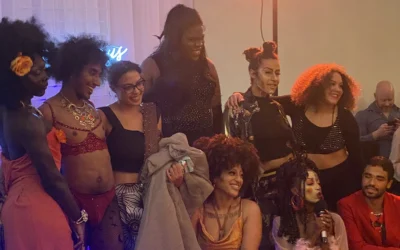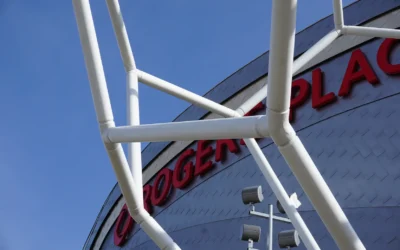This fall marks the opening of a very special public art installation in Edmonton. ÎNÎW River Lot 11∞ is a permanent, curated art exhibit that includes six original works from Canadian artists, and will be located in Queen Elizabeth II Park. ÎNÎW, pronounced (EE-NU) is a Cree word meaning “I am of the Earth.”
The project began in 2013, and received funding from the City in 2014. Following the approval of the funding, a steering committee was formed for the project. The committee includes members from the City of Edmonton, Edmonton Arts Council, Confederacy of Treaty Six First Nations, Métis Nation of Alberta, Elders, and Indigenous artists/community members.
Amy Malbeuf, Tiffany Shaw-Collinge, Duane Linklater, Jerry Whitehead, Mary Anne Barkhouse, and Marianne Nicolson are the six artists whose pieces have been selected as the permanent fixtures of the installation. The works they are contributing to the Indigenous Art Park are: iskotew, pehonan, mikikwan, mamohkamatowin (Helping Each Other), Reign, and Preparing to Cross the Sacred River, respectively. According to the City of Edmonton’s website, the artists were “required to engage with Treaty No. 6 First Nations, Métis people and other Indigenous citizens of Edmonton, and to work with Indigenous knowledge holders and Elders to ensure that the artworks will be relevant and meaningful to this place.”
Candice Hopkins, the curator of the Indigenous Art Park, says that the project has been an innovation in the way that public art is created from its inception. She explains that while it is an uncommon practice, keeping in mind how art can relate to the place it’s in was one of the driving forces behind the process used to create the design the art installation.

Hopkins says, “It’s important to note that what we really saw framing the art works for the art park is place itself. And when we said this place, we meant specifically the place of the art park but also thinking about place very deeply.”
“There’s a term being used now called deep history, and that’s to think about history not just in human terms, but to think about how human culture has shaped land and shaped space, and to think about the land’s own history in a kind of geological time as well. I think we were interested in looking at this broad a scope of this land and this place that is now the art park,” she explains.
This ideology guided the process that the steering committee and artists used to create the installation. They began by hosting a number of workshops and site visits. They also brought in a variety of knowledge keepers, including Jerry Saddleback Sr. who, “imparted and continues to impart a great deal of his knowledge of this place coming from a Cree perspective,” says Hopkins.
The artists and steering committee worked alongside numerous other elders, who informed the creators of the history and importance of the Saskatchewan River and the location as a gathering site for other groups such as the Dene, Blackfoot, and Métis peoples. The River Lot 11 site is also where Joseph McDonald, one of the first Métis in the area, lived with his family for many years. The land that was historically the reserve of Chief Papaschase’s Band, who signed an adhesion to Treaty Six, is also close by.
The location of the site holds significance for the entirety of the project, from the individual art pieces to the way the committee engaged with the community to design the concept of the park.
Hopkins says that the committee was particularly influenced by “the fact that this is a place of overlapping histories. Of course history is — you could consider it a bit like rock sediment where there’s these different layers of the way that people have always used the land, considered the land, taken care of the land, and the way that the land has also taken care of those people.”
In her experience, when public art is commissioned, artists are expected to respond to a site but aren’t often given much background or history — or the varying perspectives included within that history — on the site itself. This was an approach that the steering committee of the ÎNÎW River Lot 11∞ Indigenous Art Park wanted to rethink and redesign. Hopkins wanted to give all participants every chance to immerse themselves in the varying histories of the site and to realize the importance that place would have on the artwork featured.
“Up front, artists were given a lot of opportunity to engage. To engage with people who had very different perspectives of Edmonton, who had different knowledge to impart, and not just cultural leaders but also other artists. Poets, like Marilyn Dumont for example — among others,” explains Hopkins.
She also says you can see the difference that this process made in each of the six artworks that the committee selected.
“Each of them brings a different perspective of this place and I think a different way of engaging and understanding land: its history, its people, as well as its future,” she says.
Hopkins also reinforces that the “art park is a curated space, which means that all of the works within the space have relationships to one another.”
She says that one of the threads that runs through the artworks is “the importance of oral narratives, because this is the way that indigenous history has been taught, the way that it has been received, over generations.”
Hopkins highlights artist Tiffany Shaw-Collinge’s artwork, “a small amphitheatre where people people can gather, they can tell stories, they can debate, and they can engage with the space as a place where you can gain knowledge. Which I think is along the way, the way that it has always been used, and in fact she’s signalling that with the title.”
Beyond the immediate importance the art installation holds for the site, and vice versa, Hopkins also says that the creation of the art park is a sign of shifting cultures within Edmonton.

“This is mainstream society becoming aware of Indigenous ideologies and practices, and this is why it is so important to have these kinds of public initiatives. I think people truly feel represented in a place when they see themselves in it,” she says.
Edmonton is home to Canada’s second-largest urban indigenous community and has one of the country’s fastest growing populations of indigenous peoples. Hopkins laments that despite the presence of this large indigenous community, “indigenous people are not really represented in the public sphere,” in terms of public art — although this is slowly changing — or in our city’s monuments.
Hopkins also says, “monuments often aren’t the way that we do things, because monuments serve a different purpose in history and marking and fixing things,” and that, “you could even understand some of the artworks in the artpark as anti-monuments in a way, because they’re questioning how monuments are often embracing and reiterating colonial narratives.”
Her hope is “that the Art Park then becomes not just a space for people to gather, but a space for people to learn histories and perspective that they might not have known before. It also becomes a place of engagement.”
She says that the Art Park has been a collaboration and a place of engagement throughout its construction.
“I think it’s important to note that these artworks are coming from individual artist’s visions, but those visions have also gathered all of these other stories and perspectives on the way. Certain (art pieces), like Jerry Whitehead’s turtles are made indeed with community members and with that perspective as well.”
Hopkins believes the “process of learning from this place, from the people who were in this place,” was reflected “back in the artwork itself,” and will affect the way that the community engages with the installation in the future.
Hopkins also hopes that the success of this approach will transcend this project, affecting the way that public art installations are conceived, designed, and created in the future.
“What we’ve also done I think is create a kind of different model for the development of public artworks and that is by a deep engagement with place, by thinking about knowledge keepers very broadly, by engaging those knowledge keepers, and by using the land and the histories embedded in the land as the basis for the artworks, and not the other way around.”
Photography by Derrick Ferry.





0 Comments